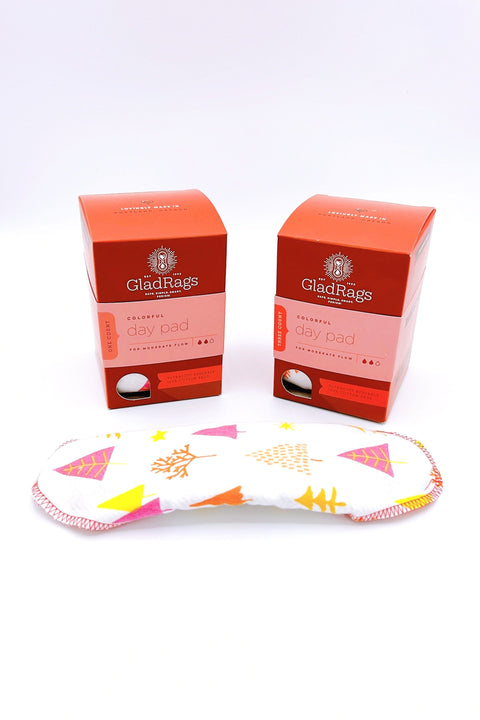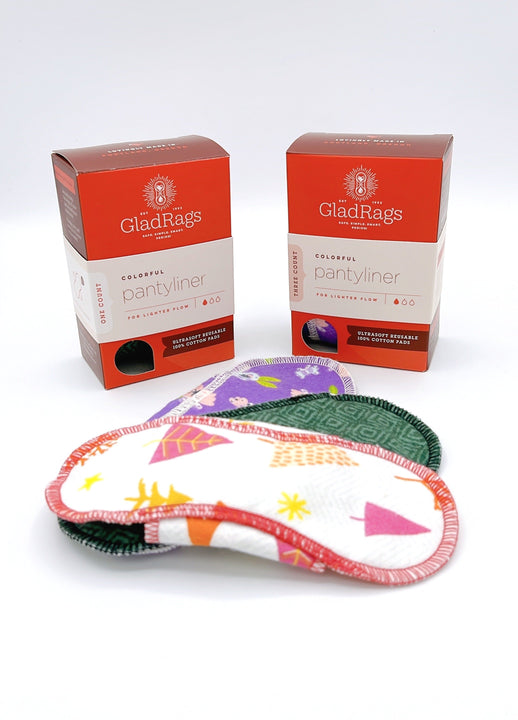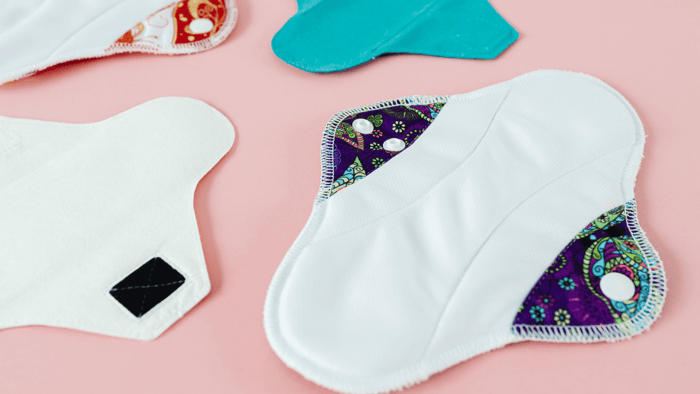For many people, menstruation is an essential part of life that involves finding products that help manage their flow comfortably and effectively. However, many of the products that are commonly used—like disposable menstrual pads—have negative implications for both health and the environment. Over the past few years, more and more individuals have started to shift toward more sustainable options, such as reusable menstrual pads, which offer numerous benefits over their disposable counterparts. If you're contemplating this shift, let’s explore why reusable pads might be the healthier, greener choice for your period.
The Environmental Toll of Disposable Pads
Each year, millions of people worldwide use disposable pads, but the environmental impact is substantial. In the U.S., 12 billion pads and 7 billion tampons end up in landfills annually[^1]. These single-use products significantly contribute to waste. Many disposable pads also contain plastic-based materials like polyethylene and polypropylene, which can take up to 500 years to break down, worsening the growing problem of non-biodegradable waste.
Moreover, disposable pads often contain chemical additives, such as bleaching agents and fragrances, which can leach into the soil when disposed of, potentially harming the environment. They also require substantial energy and raw materials to manufacture, making their carbon footprint much higher than reusable options.
The total environmental impact goes beyond just waste. A study by the World Health Organization (WHO) estimates that menstrual products contribute to around 245,000 tonnes of CO₂ emissions every year[^2]. When you consider the number of individuals worldwide who use disposable menstrual products, this statistic becomes even more alarming.
Furthermore, improperly disposed of pads can make their way into waterways, where plastics contribute to pollution. As they degrade, these plastics break down into microplastics, which pose a threat to aquatic life and can eventually enter the food chain.
Health Considerations
When considering menstrual products, it’s crucial to pay attention to what touches our skin, especially in sensitive areas. Disposable pads often contain chemicals like synthetic fragrances, bleach, and other materials that may irritate the skin. These chemicals can lead to discomfort, rashes, or allergic reactions.
In contrast, reusable menstrual pads are typically crafted from natural, breathable materials like cotton, bamboo, or hemp. These fabrics are free from chemicals, dyes, and plastics, making them much kinder to the skin. Many people who have made the switch to reusable pads report fewer irritations, rashes, and allergic reactions, as the materials are more gentle and less likely to cause discomfort.
Additionally, disposable pads can create a moist environment that increases the risk of bacterial growth, yeast infections, or urinary tract infections (UTIs). Reusable pads, however, are more breathable, which allows for better airflow and moisture management. As a result, the risk of infections is significantly reduced.
The Benefits of Reusable Menstrual Pads
Environmental Sustainability
One of the main reasons people choose reusable menstrual pads is their eco-friendliness. A single reusable pad can last between 3 to 5 years with proper maintenance, while disposable pads are discarded after each use, contributing to landfill waste. By making the switch to reusable pads, an individual can prevent the disposal of thousands of single-use pads over their lifetime, significantly reducing their environmental impact.
Cost-Effective
While reusable pads may require a higher upfront investment, they are incredibly cost-effective in the long run. A set of high-quality cloth pads can last up to 5 years or more. When you compare that to the constant monthly cost of disposable pads (which can total $100+ per year), the savings are substantial. By switching to reusable pads, you could save over $3,800 in a lifetime by avoiding the need for disposable products.
Comfort and Health
Reusable menstrual pads are made from soft, natural fabrics like organic cotton or bamboo, making them much more comfortable to wear compared to their disposable counterparts. Many disposable pads contain plastics that trap moisture and can irritate sensitive skin. Reusable pads, however, are breathable and absorbent, reducing the risk of chafing, rashes, or discomfort during menstruation.
Customizable Options
Reusable pads are available in a wide range of sizes, absorbencies, and designs, making it easy for individuals to customize their menstrual care routine. Whether you need a light liner, a heavy-duty pad for overnight protection, or something in between, there’s a reusable pad that fits the bill. For those with a lighter flow, a thinner pad may suffice, while those with a heavier flow can opt for night pads or longer pads with extra absorbency.
Variety of Materials
Not all reusable menstrual pads are the same, and finding the right one can depend on your preferences. From 100% cotton to bamboo fabric, there’s a range of natural materials that can suit different skin types and preferences. Additionally, for those looking to avoid plastic altogether, brands like GladRags offer 100% cotton pads with no polyurethane or synthetic materials.
| Feature | Reusable Pads | Disposable Pads |
|---|---|---|
| Material | Natural fabrics (cotton, bamboo, hemp, etc.) | Synthetic materials (polyethylene, polypropylene, etc.) |
| Lifespan | 3-5 years with proper care | Single-use, discarded after each cycle |
| Environmental Impact | Low impact, biodegradable, reduces landfill waste | High impact, contributes to landfill waste for hundreds of years |
| Health Benefits | Gentle on skin, no chemicals, reduces irritation | May contain chemicals, fragrances, and synthetic materials that cause irritation |
| Cost Over Time | More cost-effective in the long run (reusable) | Ongoing cost due to monthly repurchase |
| Comfort | Soft, breathable, and customizable | May cause discomfort due to plastic lining and chemicals |
| Maintenance | Requires washing and care after each use | Simply discarded after use |
| Absorbency Options | Available in various absorbencies (light, moderate, heavy) | Limited options; typically one size fits all |
| Packaging | Eco-friendly, minimal waste packaging | Often comes in plastic packaging |
| Variety | Customizable sizes, shapes, and designs | Limited sizes and designs |
Sources:
Environmental Impact of Disposable vs. Reusable Pads:
"The Impact of Disposable Menstrual Products" by The Environmental Protection Agency (EPA) and other environmental organizations. These sources detail the environmental concerns regarding single-use menstrual products.
Health Benefits and Comfort:
Studies on "Menstrual Health and Product Ingredients," which address the issues of chemicals and irritation from synthetic materials in disposable pads (Source: The National Institutes of Health, NIH).
Cost and Longevity:
Reports on the cost comparison between reusable and disposable menstrual products over time (Source: Environmental Research Letters, 2021).
Maintenance and Absorbency Options:
Insights from manufacturers like GladRags and other reusable pad brands that detail the materials, care instructions, and absorbency options available with their products.
Packaging Impact:
The Packaging Project: An Overview of the Effects of Packaging Waste, including statistics on the plastic waste generated by disposable menstrual products (Source: Greenpeace and The Natural Resources Defense Council, NRDC).
Addressing Common Concerns: Plastic in "Reusable" Products
Some reusable menstrual pads still contain small amounts of synthetic material, such as polyurethane liners or polyester layers, despite being marketed as “reusable” or “eco-friendly.” Many consumers are frustrated to discover that their reusable options still have plastic components, which defeats the purpose of choosing sustainable products.
If you are specifically looking for plastic-free and 100% natural pads, brands like GladRags are great options. GladRags offers reusable menstrual pads made entirely of cotton, from the top layer to the absorbent core, ensuring there are no plastics involved.
One user shared that she has been using cloth pads for over 10 years, starting when she was also cloth diapering her child, and she has never looked back. She finds them more comfortable, environmentally friendly, and more affordable than disposables.
A Brand That’s Leading the Way
GladRags stands out as a leader in sustainable and comfortable menstrual products. Since its inception in the late 1980s, the brand has been dedicated to offering 100% cotton reusable pads, free from harmful synthetic materials. With a focus on quality and care, GladRags ensures its products are both eco-friendly and highly effective.
GladRags offers a wide variety of cloth pads, including pantyliners and overnight pads, designed to meet the needs of menstruators with different flows. What sets GladRags apart is their commitment to transparency—their products are made using fair labor practices, and they work with women-owned sewing companies to ensure ethical production.
GladRags pads feature fun, vibrant patterns and are made from soft, natural fabrics that feel great against the skin. They're designed for comfort and built to last, making them a reliable choice for anyone looking to cut down on waste while supporting ethical, eco-conscious brands.
GladRags Pads

$15.00
Your Eco-Friendly, Comfortable, and Stylish Choice! Say hello to the GladRags Reusable Pad—your new best friend for menstrual and incontinence care. Made from high-quality cotton, these reusable sanitary pads are free from harmful chemicals, making it a safe and natural… read more
GladRags Pantyliner

$13.00
The Best Sustainable Period Products Looking for a eco friendly pantyliner that's ultra-comfy? The GladRags Pantyliner has got you covered—literally! Made from absorbant cotton, this pantyliner is free from harmful chemicals, making it a safe and natural option for your… read more
Why People Love Cloth Pads
Many individuals who make the switch to cloth pads say they will never go back to disposable ones. A user recently shared that she has been using cloth pads for over a decade and can’t imagine going back to disposables. Another user echoed similar sentiments, praising the comfort and effectiveness of cloth pads, stating they’re a “10/10 highly recommend” option for those looking to reduce waste.
While some people initially worry that cloth pads might be bulky or uncomfortable, most find that they’re easier to get used to than they thought. And once you’ve found your favorite brand, it’s smooth sailing.
Getting Started with Reusable Menstrual Pads
If you’re considering making the switch to reusable pads, it’s easier than you might think. Here’s a simple guide to help you get started:
Start Small: Don’t feel pressured to completely switch overnight. Start by purchasing one or two pads and see how they feel. You may also want to try a reusable pantyliner for lighter days.
Establish a Wash Routine: Rinse your used pads in cold water before tossing them in the laundry. When you're ready to wash your pads, simply add them to your regular laundry load—no extra steps required. Just avoid using fabric softener, as it can reduce their absorbency.
Invest in a Wet Bag: For convenience, purchase a wet bag for when you're on the go. Wet bags are discreet, waterproof bags where you can store used pads until you get home to clean them.
Build Your Collection Gradually: Over time, you’ll find that you need fewer disposable products. As your collection of reusable pads grows, you may find that you need fewer and fewer disposable options.
Why Reusable Pads Are Worth It
The benefits of switching to reusable menstrual pads are undeniable. They provide a healthier, more eco-friendly alternative to the wasteful, often uncomfortable world of disposable menstrual products. With brands like GladRags leading the way, you have access to comfortable, effective, and sustainable options that meet your unique needs.
By choosing reusable cloth pads, you’re not only taking care of your body, but you’re also doing your part to protect the planet. So, whether you're looking to reduce your environmental impact or simply want a more natural alternative to traditional menstrual products, reusable pads are the perfect solution.
Make the Switch Today
Ready to make a positive change for both your health and the environment? It’s time to ditch the disposables and try the best reusable pads. At Mudd House Mercantile, we’re proud to offer a curated selection of sustainable products, including high-quality reusable pads from trusted brands like GladRags. Make a meaningful difference with every period—shop our eco-friendly, reusable menstrual products today and start your journey towards a more sustainable lifestyle!
Sources:
"The Environmental Impact of Disposable Menstrual Products." World Health Organization.
"Plastic Pollution: A Global Problem." United Nations Environment Programme.

